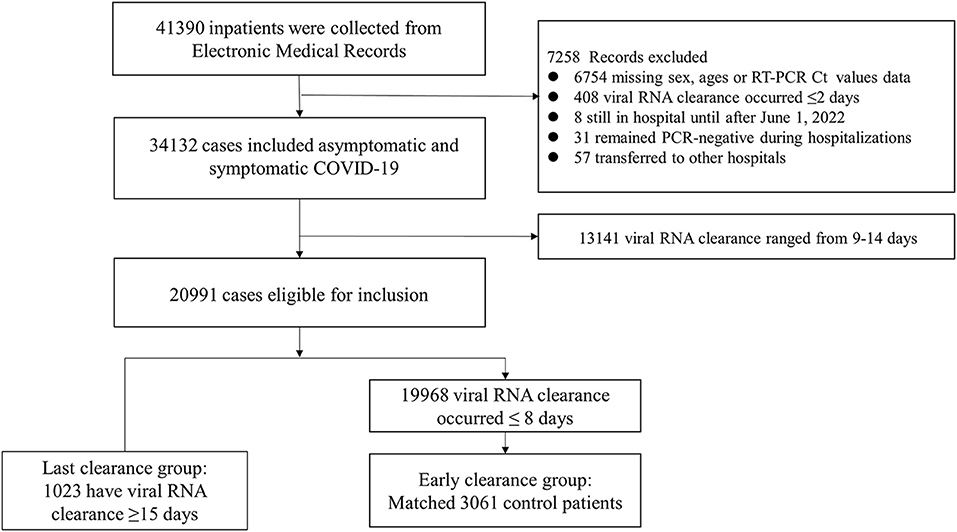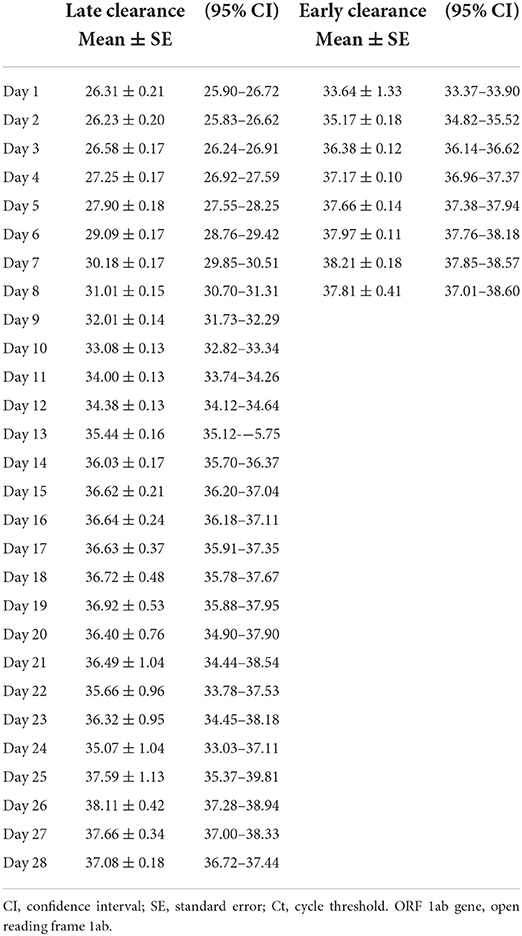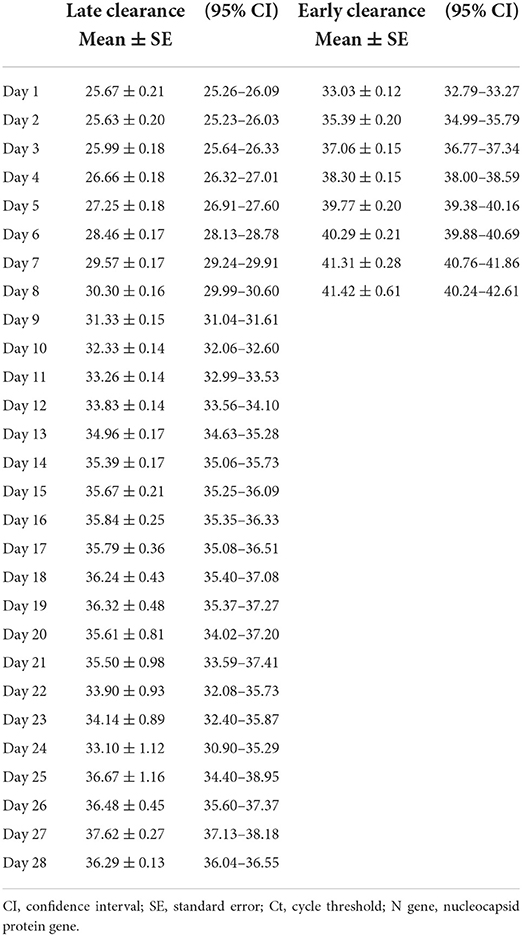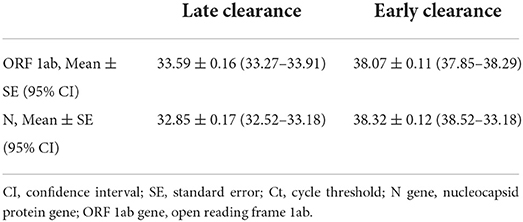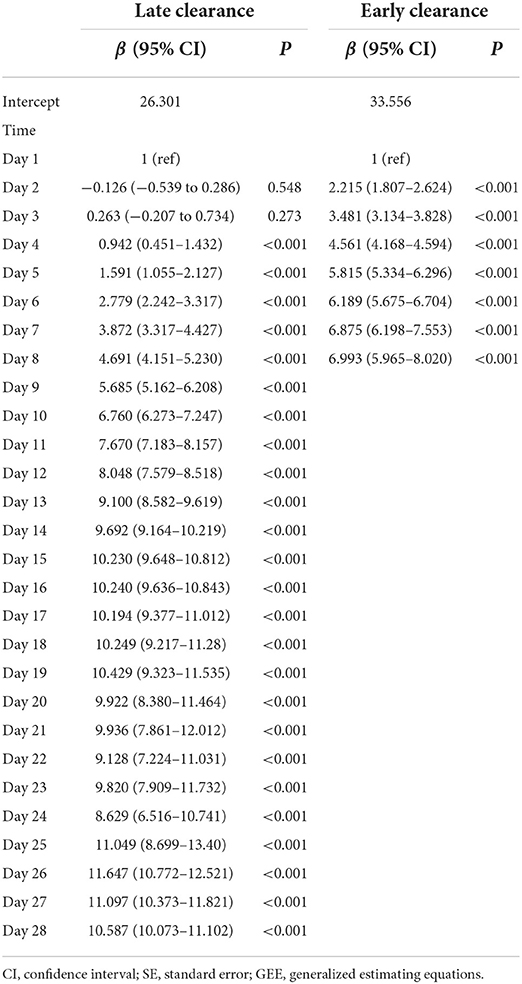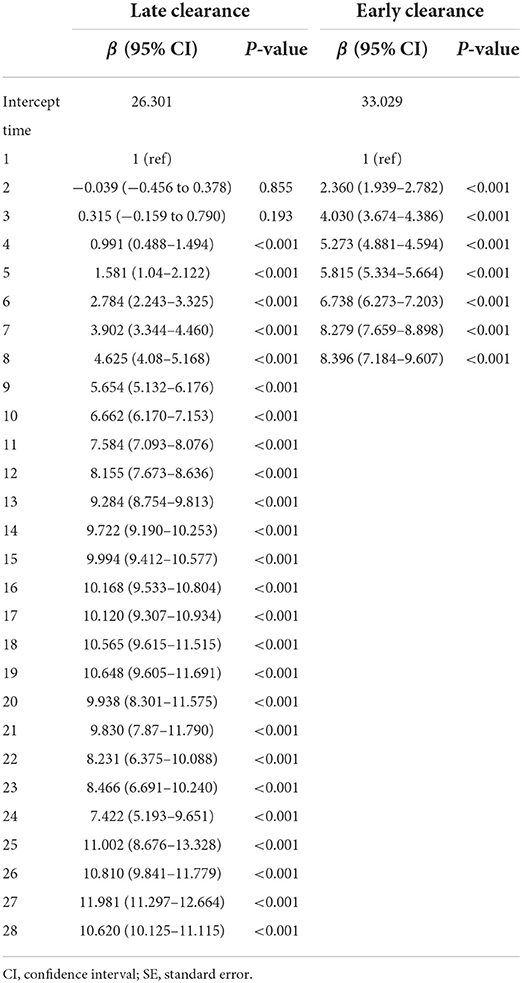- 1Department of Emergency, Longhua Hospital, Shanghai University of Traditional Chinese Medicine, Shanghai, China
- 2School of Acupuncture-Moxibustion and Tuina, Shanghai University of Traditional Chinese Medicine, Shanghai, China
- 3Department of Critical Care Medicine, The Second Affiliated Hospital of Xi'an Jiaotong University, Xi'an, China
- 4Department of Rheumatology, Longhua Hospital, Shanghai University of Traditional Chinese Medicine, Shanghai, China
- 5Department of Nursing, Longhua Hospital, Shanghai University of Traditional Chinese Medicine, Shanghai, China
- 6Department of Pediatrics, Longhua Hospital, Shanghai University of Traditional Chinese Medicine, Shanghai, China
- 7Shanghai Jiao Tong University Affiliated Sixth People's Hospital, Shanghai, China
- 8Longhua Hospital, Shanghai University of Traditional Chinese Medicine, Shanghai, China
- 9Institute of Emergency and Critical Care Medicine, Shanghai University of Traditional Chinese Medicine, Shanghai, China
Objective: To evaluate determinants of prolonged viral RNA shedding in hospitalized patients with severe acute respiratory syndrome coronavirus 2 (SARS-CoV-2) Omicron variant infection.
Materials and methods: Hospitalized patients tested SARS-CoV-2 positive by nasopharyngeal real-time reverse transcriptase-polymerase chain reaction (RT-PCR) were included in the single-center, retrospective study. Patients were divided into 2 groups according to the timing of viral clearance (≤ 8 days, “early clearance” and ≥15 days, “late clearance”).
Results: 4,084 patients were included in the study (1,023 late clearance, 3,061 early clearance), with median age of 50 years and a higher proportion (61.4%) of male. Univariate analyses showed that comorbidities (including hypertension, diabetes, and coronary heart disease), receiving vaccine, the number of vaccinations, cycle threshold (Ct) open reading frame 1ab (ORF 1ab), and nucleocapsid protein (N) gene values on admission were associated with late viral clearance. In the multivariable analysis, the number of vaccinations (P = 0.010) and Ct ORF 1ab gene (P < 0.001) values on admission were significantly associated with late viral clearance. Generalized Estimating Equations (GEE) analysis showed that the Ct value of ORF 1ab gene and N gene remained unchanged within 3 days, and showed progressively higher values with increasing days during late viral RNA clearance.
Conclusion: The number of vaccinations and Ct values of ORF 1ab gene were independently associated with a prolonged SARS-CoV-2 RNA shedding.
Introduction
The severe acute respiratory syndrome coronavirus 2 (SARS-CoV-2) Omicron variant has been continuing to spread throughout the globe since it was first confirmed on November 9, 2021, reported to WHO from South Africa on November 24, 2021. As of May 9, 2022, the number of confirmed COVID-19 cases are over 526 million globally, including more than six million deaths (1). Since late February 2022, SARS-CoV-2 Omicron variant had appeared rapidly in Shanghai, China, and subsequently became the catalyst for COVID-19 outbreaks. According to reports by Shanghai Municipal Health Commission, as of May 4, 2022, 59,3336 cases have been identified, including 53,8450 cases of asymptomatic infection (2, 3). The viral genomes in Shanghai were clustered into the SARS-CoV-2 BA.2.2 sub-lineage. More than thirty mutations found in the spike proteins of Omicron variant with enhanced transmissibility and immune escape, which is correlated with the recent exponential growth in case counts (4, 5). According to the newest National Health Commission of China report, the Omicron variant was first identified in China on December 9, 2021, and subsequently propels the pandemic in Shanghai (6). Since March 2022, Shanghai have adopted mobile cabin hospitals and appointed hospitals to isolate and treat COVID-19 patients.
Since then, more than 50,000 confirmed cases have recovered and been discharged from hospital. However, some patients with prolonged viral shedding were reported SARS-CoV-2 positive by real-time reverse transcriptase-polymerase chain reaction (RT-PCR) again after discontinuation of quarantine, which increased the complexity of disease control and has attracted widespread concerns (7). To date, several studies, mainly during the beginning of the epidemic, have been performed to investigate the clinical characteristics and virologic course of persistently positive patients. Xu et al. evaluate 113 patients who were admitted between January 13 and February 19, 2020 (8). They found that delayed admission to hospital, male, and invasive mechanical ventilation were independent factors associated with the duration of SARS-CoV-2 RNA shedding. Zhao et al. (9) retrospectively analyzed 104 patients with COVID-19 admitted to the isolation wards of our hospital from January 19 to March 18, 2020. The result showed that the clearance of viral RNA in sputum was delayed in severe COVID-19 patients, especially in those with a lower virus cycle threshold (Ct) value. Lee et al. (10) studied 1,186 asymptomatic and mildly symptomatic COVID-19 patients in South Korea. In their study, respiratory symptoms are the strongest independent predictive indicator, while age and underlying conditions were not significantly related. Hu et al. (11) supported that older age and chest tightness were independently associated with delayed clearance of SARS-CoV-2 RNA in hospitalized patient. Zamacona and his group (12) found that chronic rhinosinusitis and atopy might be associated with increased risk of prolonged viral shedding. Clinical characteristics of Omicron variant are a bit different to other variants. Takahashi et al. (13) studied virus shedding duration by analyzing clinical samples from the upper respiratory tracts of persons infected with SARS-CoV-2 Omicron variant in Japan during November 29 to December 18, 2021. The variant can be detected 10 days after diagnosis and achieved the highest proportion of virus isolates (41.7%) in 2–5 days after diagnosis. Another study analyzed the characteristics of the global perspective of Omicron, including transmission dynamic, effect on testing, and immunity (14). However, the characterization of prolonged positive cases with Omicron variant, the potential risk factors associated with persistently positive test results are still ambiguous.
According to the latest research, Omicron variant cases a mean time to nucleic acid conversion of 6.7 days (15). Our previous study with 4,264 Omicron variant patients observed detectable viral RNA in sputum or throat swabs in 8 (5–9) days after admission (16). We defined prolonged RT-PCR positivity as virus clearance time ≥15 days. Here, we conducted a retrospective study to predict risk factors influencing the persistence of SARS-CoV-2 RNA shedding, and described the clinical characteristics of prolonged positive patients and the dynamic changes of Ct PCR values with Omicron viral RNA shedding. These results may well contribute to the resolution of the current pandemic.
Methods
Ethical approval
The study received ethical approval from the Longhua Hospital, Shanghai University of Traditional Chinese Medicine Ethical Review Authority (DNR 2020-02150) and registered in the Chinese Clinical Trial Registry (ChiCTR2200060472).
Study design and participants
The retrospective and matched cohort study was conducted at the makeshift hospital set up in the Shanghai New International Expo Center between April 1 and June 1, 2022. The medical institution, which was the biggest quarantine venue in Shanghai yet, had up to 15,000 beds and hospitalizing more than 40,000 patients with COVID-19 from April 1 to June 15, 2022.
All inpatients were reported to Electronic Medical Records as being diagnosed with COVID-19 confirmed by RT-PCR analysis for SARS-CoV-2 in nasopharyngeal swabs or throat swab specimens. RT-PCR has been the gold standard for COVID-19 diagnostic testing and screening. Patients were considered to be in virologic remission based on consecutive negative RT-PCR tests with an interval of at least ≥ 24 h. RT-PCR was performed using the Shanghai BioGerm Medical Technology Co., Ltd. open reading frame 1ab (ORF 1ab) and nucleocapsid protein (N) gene kit as the sole assay, following the manufacturer's instructions.
For each subject, baseline demographic, daily updates health information on symptoms experienced, RT-PCR test results, vaccines, the level of intervention, and related outcomes were collected and recorded in Electronic Medical Records.
Procedures
We collected the data from all inpatients who were admitted as asymptomatic and symptomatic COVID-19. The diagnosis of illness at admission were assessed based on the diagnostic criteria of the ninth edition of the COVID-19 diagnosis (17). Asymptomatic carries were defined as SARS-CoV-2 positive patients without self-perceived or clinically recognizable symptoms (18). Symptomatic cases have at least one symptom, such as fever, sore throat, dry cough, malaise, and body aches or nausea, vomiting, abdominal pain, and loose stools. Prolonged viral shedding (late clearance group) was defined as a positive RT-PCR result for ≥ 15 days, as late clearance group. We selected a control population consisting in sex, ages and wards-matched COVID-19 patients (early clearance group) who turned RT-PCR negative in ≤ 8 days after admission. Exclusion criteria included (1) viral RNA clearance occurred within 8–15 days, (2) no positive swab during their hospital stay, (3) be transferred to other hospitals, and (4) be admitted as severe/critical COVID-19.
A total of 41,390 patients' data were obtained to explore the demographic characteristics, clinical features, and risk factors for prolonged viral shedding. Of those, 6,754 cases with missing data on sex, ages, or RT-PCR cycle Ct values, 408 patients with viral RNA clearance occurred less than or equal to 2 days, eight patients who may not be discharged on June 1, 2022, 31 patients remained PCR-negative during hospitalizations and 57 patients transferred to other hospitals were excluded from this analysis. Ultimately, 13,141 patients with viral RNA clearance occurred range from 9 to 14 days were excluded. Among the remaining 20,991 cases, 1,023 have viral RNA clearance occurred ≥15 days, with 19,968 patients' viral RNA clearance occurred ≤ 8 days. Three control individuals were randomly matched by sex, ages and wards by Stata MP 17 for every patient with viral RNA clearance occurred ≤ 8 days. Finally, a total 4,084 hospitalized COVID-19 patients confirmed by RT-PCR nasopharyngeal swab samples testing were analyzed. The flow chart of study was showed in Figure 1.
SARS-CoV-2 RNA detection using real-time RT-PCR
Novel Coronavirus (2019-nCoV) Nucleic Acid Detection Kit (PCR-Fluorescence Probing) (BioGerm, China), which targets amplified ORF1ab and N genes of SARS-CoV-2, was used for SARS-CoV-2 RNA detection according to the manufacturer's instructions. In brief, reaction mixtures were prepared with nucleic acid amplification reaction solution, enzyme mixture and ORF1ab/N reaction solution in 20 μl reaction tube. SARS-CoV-2 RNAs were extracted. RNA template and control solutions were separately added into reaction tube in 25 μl per reaction. The reaction conditions were as follows: reverse transcription at 50°C for 10 min; pre-denaturation at 95°C for 5 min; denaturation at 95°C for 10 s and then annealing and elongation at 55°C for 40s (40 cycles). Fluorescence monitoring were conducted at 55°C. The CT value of each target gene can be reported. If the CT value was <35, then the patient defined as a positive result.
Data collection
We retrospectively collected the data from patients' electronic medical records, including ages, sex, basic disease, vaccine, race, symptoms, duration of viral RNA shedding, and Ct values of ORF 1ab and N genes. The date of diagnosis onset was also recorded. The first RT-PCR test took place at admission. At least three samples were obtained from each person until two consecutive negative PCR test results were obtained. The same type of sample was obtained in subsequent samples for follow-up. All patients were tested more than two consecutive negatives, and the first viral test date was used to define the duration of shedding.
Statistical analysis
Continuous variables were expressed as medians with interquartile ranges (IQRs) and were compared by Kruskal-Wallis test. Categorical variables were expressed as number (%) and compared by chi-square (χ2) test or Fisher's exact test. Significant risk factors identified in univariate analyses were further analyzed by multivariate logistic regressions to identify independent risk factors associated with the prolonged duration of SARS-CoV-2 shedding. We used the stratified Generalized Estimating Equations (GEE) to compare viral clearance at different times. The dependent variable were the Ct values of ORF1ab and N gene. Linear GEE models were used for continuous outcome variables. The model allowed for the change with time to vary based on groups. We adopted the autoregressive (AR-1) covariance as the working covariance structures in the GEE estimation. All statistical analyses were performed using SPSS (version 25.0) and Stata MP (version 17) software. The significance level of the hypothesis tests was set at 0.05 (2-sided).
Results
Clinical characteristics of patients in this study
A total of 4,084 patients were included in the study for final analysis, and 1,023 of those had viral RNA shedding more than or equal to 15 days, and 3,061 control patients had persistent negative viral detection results less than or equal to 8 days. The median time from illness onset to hospital admission for all enrolled patients was 2 days (IQR, 1–3 days). The baseline characteristics were as summarized in the Table 1.
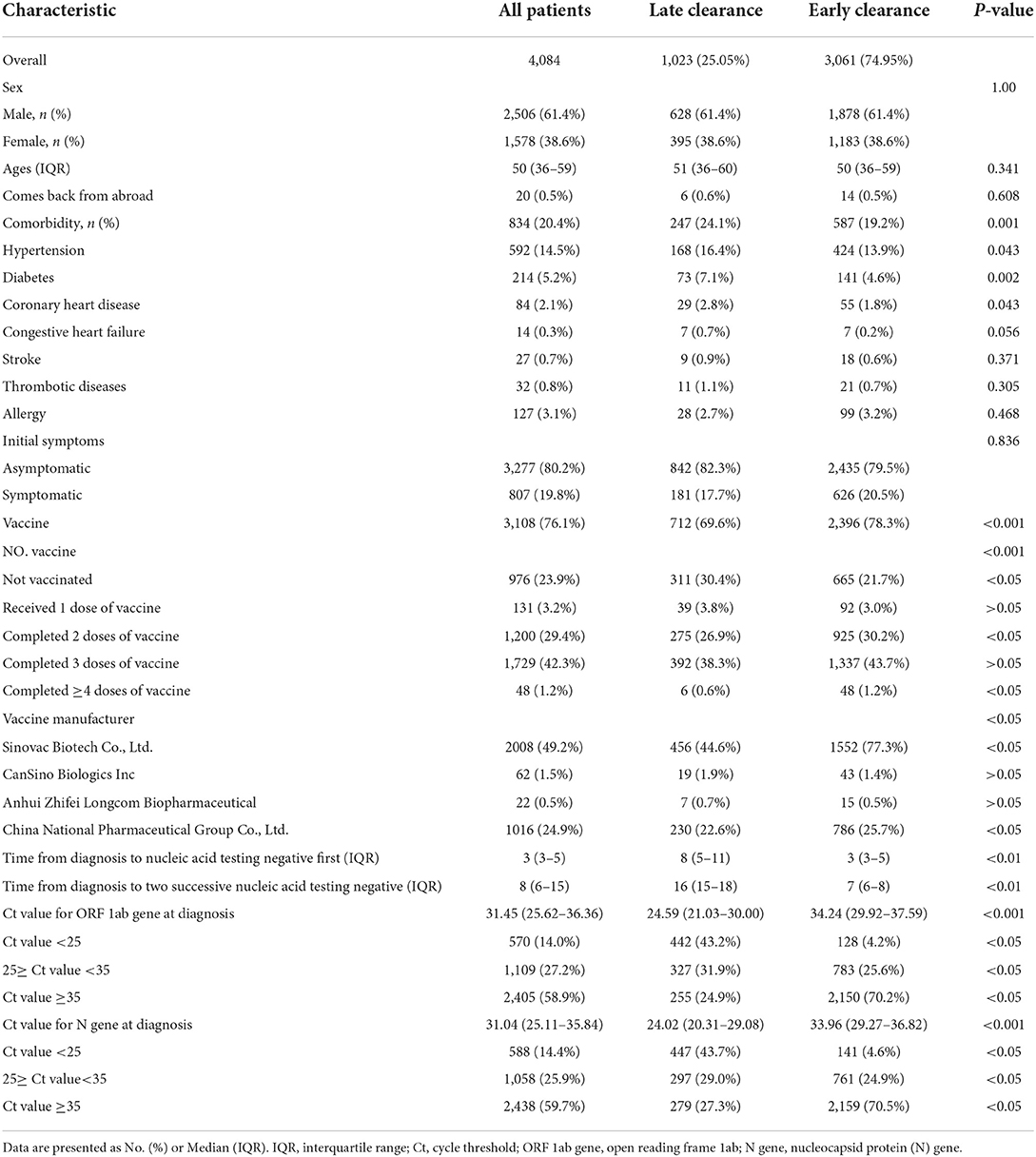
Table 1. Characteristics of included cases and controls tested for SARS-CoV-2 in Shanghai access to testing, China, April 1–June 1, 2022.
Of 4,084 cases, the median age was 50 (IQR, 36 to 59; range, 2 to 87), 38.6% (1578/4084) were female, and 61.4% (2506/4084) were male. The most common comorbid conditions (20.4%) were hypertension (14.5%), followed by diabetes (5.2%), coronary heart disease (2.1%), congestive heart failure (0.3%), stroke (0.7%), and thrombotic diseases (0.8%). Among the patients, most of those had no symptoms (80.2%), while 19.8% cases had symptoms. A total of 3,108 (76.1%) cases received vaccine with 1 dose (3.2%), 2 dose (29.4%), 3 dose (42.3%), or more than 3 dose (1.2%). These vaccine manufacturers included Sinovac Biotech Co., Ltd. (49.2%), CanSino Biologics Inc (1.5%), Anhui Zhifei Longcom Biopharmaceutical (0.5%), China National Pharmaceutical Group Co., Ltd (24.9%). The median Ct values are 31.45 (25.62–36.36) for ORF 1ab gene, and 31.04 (25.11–35.84) for N gene (Table 1).
We grouped patients according to Ct values as low (<25), high (25≥, <35), and the negative (≥35). For ORF 1ab gene, 570 (14.0%) patients had Ct values <25, 1,109 (27.2%) patients had Ct values between 25 and 35, and 2,405 (58.9%) patients had Ct values ≥35. For N gene, 588 (14.4%) patients had Ct values <25, 1,058 (25.9%) patients had Ct values between 25 and 35, and 2,438 (59.7%) patients had Ct values ≥35 (Table 1).
No significant differences between the groups were observed for sex, ages, coming back from abroad, congestive heart failure, stroke, thrombotic diseases, allergy, the presence of symptoms. The median duration of viral shedding of these prolong RNA positive patients was 16 days (IQR, 15–18 days), while seven (6–8) in control group. The median duration of these prolonged RNA positive patients testing negative first was 3 days (IQR, 3–5 days), while eight (5–11) in control group (Table 1).
ORF 1ab gene Ct values were significantly higher compared with control patients (median 33.96 vs. 24.41; p < 0.01, respectively); N gene Ct values was significantly higher compared with control patients (median 23.96 vs. 32.90; p < 0.01, respectively).
Crude and independent factors associated with persistently PCR positive
The primary purpose of this study was to observe the risk factors related with occurrence of persistently viral RNA clearance. Among 41,390 enrolled patients, there were 1,023 patients who had viral RNA clearance ≥ 15 days after diagnosis onset. The matched patients had persistent positive viral detection results less than 8 days after diagnosis onset (n = 3061).
Table 2 summarized the results of univariate analysis. We evaluated the effect of each factor on prolonged viral RNA clearance by logistic regression. Concomitant comorbidity (p = 0.001), hypertension (p = 0.043), diabetes (p = 0.002), coronary heart disease (p = 0.043), vaccine (p < 0.001), numbers of vaccine (p < 0.001), ORF 1ab gene (p < 0.001) and N gene Ct value (p < 0.001) on admission were significantly related to prolonged viral shedding (Table 2, Figure 2).
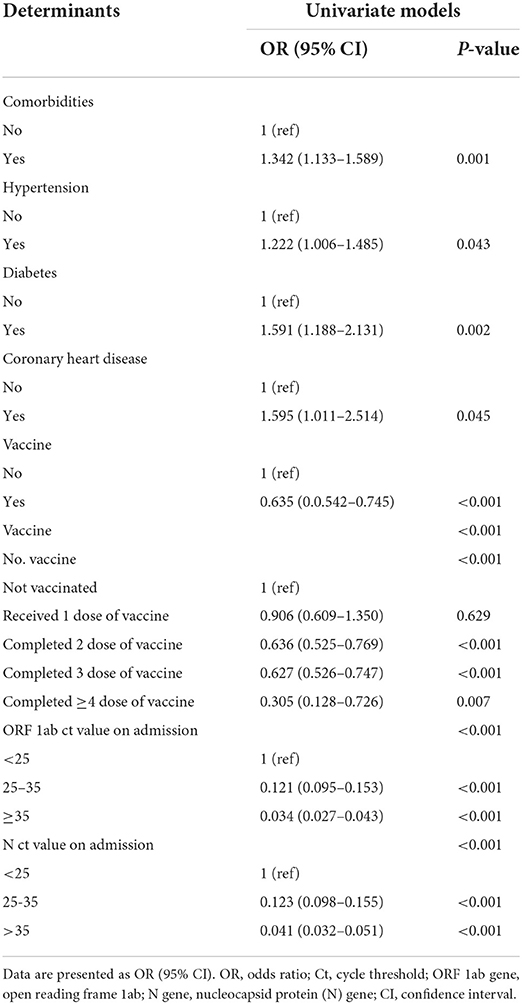
Table 2. Factors associated with persistently PCR-positive patients at univariate regression analysis.
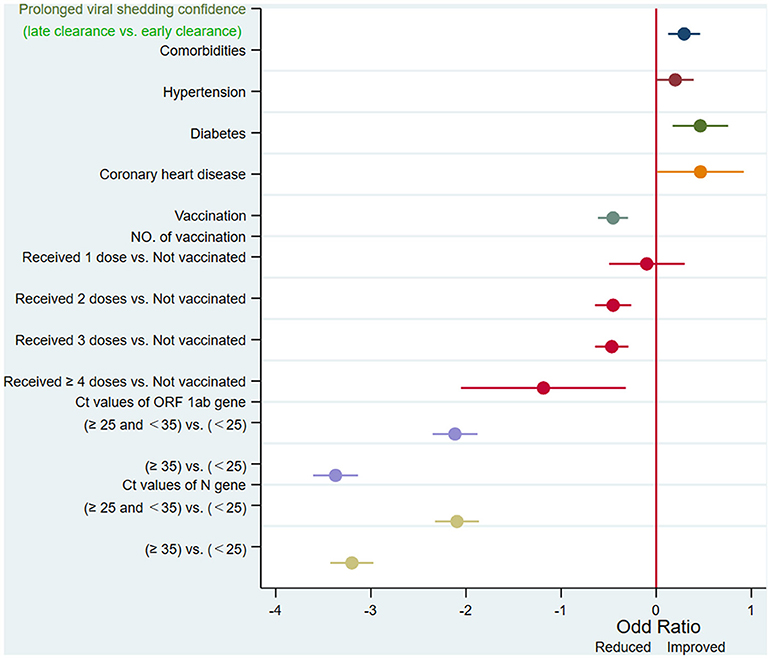
Figure 2. Factors associated with persistently PCR-positive patients at univariate regression analysis. Ct, cycle threshold; ORF 1ab gene, open reading frame 1ab; N gene, nucleocapsid protein gene.
Multivariate logistic regression was then performed with the significant factors selected by unadjusted and adjusted univariate analysis. Multivariate binary logistic regression analysis model found that the doses of vaccination (2 doses, OR 0.781, p < 0.031; 3 doses, OR 0.708, p = 0.001), and ORF 1ab gene high (OR: 0.122, 95% CI: 0.096–0.155), and negative (OR: 0.035, 95% CI: 0.028–0.045). Ct values at admission, were independently associated with prolonged RT-PCR positive test results (Table 3, Figure 3).
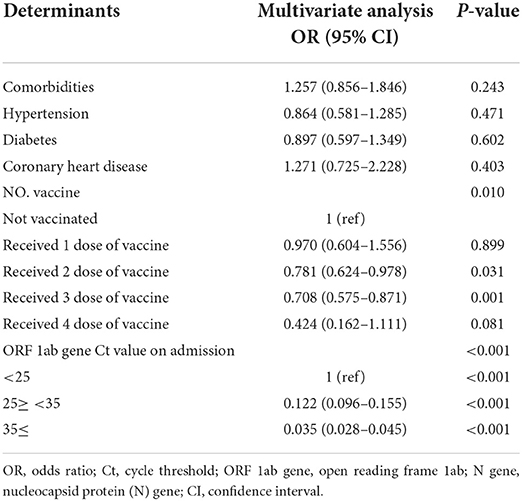
Table 3. Independent predictors of persistently PCR-positive patients identified by unadjusted and adjusted multivariate logistic regression models.
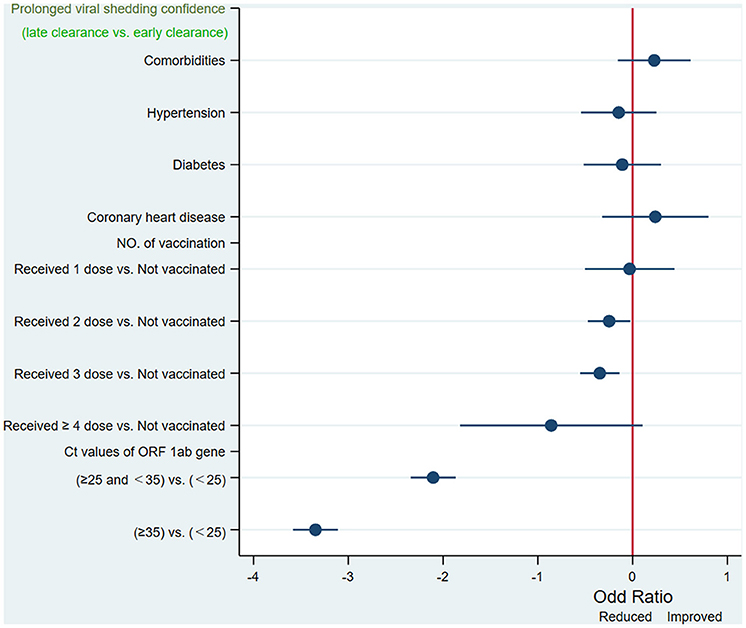
Figure 3. Independent predictors of persistently PCR-positive patients identified by unadjusted multivariate logistic regression models logistic regression. Ct, cycle threshold; ORF 1ab gene, open reading frame 1ab.
GEE estimation of factors associated with time and RNA Ct value
Figures 4, 5 show the increases of Ct values generally over time in both early and late-viral-RNA-clearance groups. Viral loads in nasopharyngeal swabs were estimated with Ct values by RT-PCR. For late-viral-RNA-clearance patients, the mean Ct values for RT-PCR on ORF 1ab gene was 33.59 (95%IC: 33.27–33.91), and on N gene was 32.85 (95%IC: 32.52–33.18; Tables 4, 5). Among prolonged-positive patients, terminal positive tests were a mean of 10.61 cycles and 10.62 cycles higher than first positive tests for ORF 1ab gene and N gene respectively. For early-viral-RNA-clearance patients' terminal and initial tests, terminal positive tests had a mean of 4.17 cycles and 8.39 cycles greater than initial positive tests for ORF 1ab gene and N gene respectively (Table 6). GEE estimation was undertaken in both groups respectively. The ORF gene and N gene CT values of patients with late-viral-RNA-clearance remained unchanged within 3 days, and showed progressively higher values with increasing days (β ranged over = 0.942–11.647 for ORF gene; 0.991–11.981 for N gene, p < 0.001; Tables 7, 8).

Figure 4. Ct values of ORF 1ab gene over time after admission. Ct, cycle threshold; ORF 1ab gene, open reading frame 1ab.

Figure 5. Ct values of N gene over time after admission. Ct, cycle threshold; N gene, nucleocapsid protein gene.
Discussion
Despite the amount of research published during the continuous COVID-19 pandemic, there is still a dearth of literature about factors possibly influencing prolonged SARS-CoV-2 Omicron variant shedding. The present study was conducted to identify clinical characteristics and factors associated with prolonged RT-PCR positivity for Omicron variant patients. We classified patients based on their length of RNA shedding, and observed that 25.05% of the 1,023 study patients required more than 15 days to achieve a negative viral RNA test. Moreover, 3,061 individuals were matched by the timing of diagnosis, sex, ages, wards, with viral RNA clearance occurred less than or equal to 8 days. Our findings showed the median interval from diagnosis to SARS-CoV-2 nucleic acid conversion in prolonged positivity patients was 16 days, shorter than the 21 days in many previous reports (8, 19). Bennasrallah et al. (20) found that negative conversion of SARS-CoV-2 RNA occurred 20 days (IQR: 17–32 days) from the first positive RT-PCR test. Another study in Italy reported a longer median duration of the nucleic acid conversion negative of 31 days (IQR 24–41 days) (21). Ling et al. (6) found the median time from the onset of symptoms to first negative conversion results of oropharyngeal swabs in convalescent patients was 9.5 (6.0–11.0) days. The discrepancies between studies might attribute to differences in disease severity, sampling methods, as well as the varieties of virus. These results might suggest that Omicron variant was relatively less severe than previous strains (22).
Our study population have a mean age of 50 years and included a higher proportion (61.4%) of male. These demographic characteristics were comparable to the patients in studies reported in 2020 (23). As control patients were matched by sex and age, there were no gender or sex difference between the two groups. However, a study conducted by cox regression multivariate analysis revealed that growth of age was correlated to later RT-PCR conversion (11).
Our finding showed that 82.3% of the reported COVID-19 cases were asymptomatic, while in studies reported in 2020, all patients had at least one symptom and 34.2% of those developed severe COVID-19 (8). COVID-19-positive cases with at least one chronic comorbidity had higher percentage in the prolonged-viral-RNA-shedding group. Hypertension, diabetes, and coronary heart disease were the most frequent chronic comorbidities reported in our COVID-19 Omicron variant population. However, these comorbidities were not significant risk factors in the logistic regression model.
On admission, almost 83% were asymptomatic COVID-19 cases, while 19.7% were at least one symptom. Interesting, our results showed there were no different in a duration of viral shedding between asymptomatic and symptomatic patients. A previous study on 70 patients hospitalized with COVID-19 demonstrated clinical classification (symptomatic and asymptomatic) was not a significant predictor for the time to RT-PCR conversion (24). Carmo et al. (25) indicated that prolonged viral RNA is not necessarily related to severe disease, as mild illness patients discharged home took longer to convert negative than inpatients.
There have been no specific antiviral drugs for SARS-CoV-2. In our study, the percentage of patients with vaccination at least one dose was lower in late-clearance group than early-clearance group. Multivariate logistic regression showed vaccination, especially 2 or 3 doses of vaccination, was significant related to prolonged nucleic acid conversion time. Wu et al. (26) conducted a retrospective cohort, enrolling 142 patients with no or mild symptoms, to evaluate whether vaccination could improve the disease course of SARS-CoV-2 Omicron variant. The result found that but patients with vaccination had shorter time to target cycle threshold value.
Additionally, Ct values may be an important proxy for infectivity. Our results suggest that viral-RNA Ct values on admission were supported as an independent factor related to prolonged RT-PCR positivity. Patients were at a higher risk of having a higher viral load than control patients, during a prolonged period of time. And Ct values of RT-PCR test in throat swab peaked at around 2–3 days after admission. Pan et al. (27) supported viral loads in throat swab and sputum samples peaked at around 5–6 days after symptom onset.
This study had some limitations. First, although viral RNA was detected in most of the studies, viral RNA shedding cannot exactly represent viral shedding. So far, viable and nonviable viruses on nasopharyngeal swab cannot be distinguished by RT-PCR for SARS-CoV-2 RNA. Second, the study ignored patients who recovered PCR negative 9-14 days after initial PCR positive.
Conclusion
In conclusion, prolonged SARS-CoV-2 RNA shedding was independently associated with vaccination and ORF 1ab gene viral-RNA Ct values. These results emphasized that hospital admission and vaccination should be started as soon as possible in patients with COVID-19. Understanding the virological dynamics during the process of illness should be helpful in the clinical management of patients with COVID-19.
Data availability statement
The raw data supporting the conclusions of this article will be made available by the authors, without undue reservation.
Ethics statement
The studies involving human participants were reviewed and approved by the Longhua Hospital, Shanghai University of Traditional Chinese Medicine Ethical Review Authority (DNR 2020-02150) and registered in the Chinese Clinical Trial Registry (ChiCTR2200060472). Written informed consent to participate in this study was provided by the participants' legal guardian/next of kin.
Author contributions
BF, HH, and SZ study conception and design. DS and MC acquisition of clinical and drug concentration data. WL, LS, XX, YP, CC, YS, and HY analysis and interpretation of data. WZ, GW, and YG wrote manuscript. All authors contributed to the article and approved the submitted version.
Funding
Funding for this study was provided by National Key R&D Program of China (2018YFC1705900); State Administration of Traditional Chinese Medicine, traditional Chinese medicineon prevention and treatment of novel Coronavirus pneumoniaemergency and special project (2022ZYLCYJ05-3 and 2022ZYLCYJ05-4); and Shanghai University of Traditional Chinese Medicine, traditional Chinese medicine on prevention and treatment of novel Coronavirus pneumonia emergency and special project (2022YJ-03 and 2022YJ-06).
Acknowledgments
We acknowledge the patients who participated in the study and the nursing staff who all assisted in collection of data and cared for patients, from the makeshift hospital set up in the Shanghai New International Expo Center in Shanghai.
Conflict of interest
The authors declare that the research was conducted in the absence of any commercial or financial relationships that could be construed as a potential conflict of interest.
Publisher's note
All claims expressed in this article are solely those of the authors and do not necessarily represent those of their affiliated organizations, or those of the publisher, the editors and the reviewers. Any product that may be evaluated in this article, or claim that may be made by its manufacturer, is not guaranteed or endorsed by the publisher.
References
1. World Health Origanization [EB/EO]. Weekly epidemiological update on COVID-19. Available online at: https://www.who.int/publications/m/item/weekly-epidemiological-update-on-covid-19-1-june-2022 (accessed June 1, 2022) (2022).
2. National Health Commission of China. Update on Coronavirus disease (COVID-19) as of 24:00 May 6, 2022 [EB/OL]. Available online at: https://wsjkw.sh.gov.cn/xwfb/20220505/ee4247315f3b472a81dbd312dfd37ad9.html (accessed May 6, 2022) (2022).
3. Zhang X, Zhang W, Chen S. Shanghai's life-saving efforts against the current omicron wave of the COVID-19 pandemic. Lancet. (2022) 399:2011–2. doi: 10.1016/S0140-6736(22)00838-8
4. Bálint G, Vörös-Horváth B, Széchenyi A. Omicron: increased transmissibility and decreased pathogenicity. Signal Trans Targ therapy. (2022) 7:151. doi: 10.1038/s41392-022-01009-8
5. Wang L, Cheng G. Sequence analysis of the emerging SARS-CoV-2 variant Omicron in South Africa. J Med Virol. (2022) 94:1728–33. doi: 10.1002/jmv.27516
6. Ling Y, Xu SB, Lin YX, Tian D, Zhu ZQ, Dai FH, et al. Persistence and clearance of viral RNA in 2019 novel coronavirus disease rehabilitation patients. Chin Med J. (2020) 133:1039–43. doi: 10.1097/CM9.0000000000000774
7. Chang D, Mo G, Yuan X, Tao Y, Peng X, Wang FS, et al. Time kinetics of viral clearance and resolution of symptoms in novel coronavirus infection. Am J Resp Crit Care Med. (2020) 201:1150–2. doi: 10.1164/rccm.202003-0524LE
8. Xu K, Chen Y, Yuan J, Yi P, Ding C, Wu W, et al. Factors associated with prolonged viral rna shedding in patients with coronavirus disease 2019 (COVID-19). Clin Inf Dis Off Pub Inf Dis Soc Am. (2020) 71:799–806. doi: 10.1093/cid/ciaa351
9. Zhao H, Tu H, Yu X, Su J, Zhang X, Xu K, et al. Delayed clearance of viral RNA in sputum for severity COVID-19 patients with initial high viral load. Inf Drug Resis. (2022) 15:1971–9. doi: 10.2147/IDR.S353688
10. Lee YH, Hong CM, Lee TH, Hwang YJ, Kim DH, Lee J, et al. Factors associated with prolonged viral detection in asymptomatic and mildly symptomatic patients with SARS-CoV-2 infection. J Inf Dev Countries. (2022) 16:291–7. doi: 10.3855/jidc.15072
11. Hu X, Xing Y, Jia J, Ni W, Liang J, Zhao D, et al. Factors associated with negative conversion of viral RNA in patients hospitalized with COVID-19. Sci Total Environ. (2020) 728:138812. doi: 10.1016/j.scitotenv.2020.138812
12. Recalde-Zamacona B, Tomás-Velázquez A, Campo A, Satrústegui-Alzugaray B, Fernández-Alonso M, Iñigo M, et al. Chronic rhinosinusitis is associated with prolonged SARS-CoV-2 RNA shedding in upper respiratory tract samples: a case-control study. J Int Med. (2021) 289:921–5. doi: 10.1111/joim.13237
13. Takahashi K, Ishikane M, Ujiie M, Iwamoto N, Okumura N, Sato T, et al. Duration of infectious virus shedding by SARS-CoV-2 omicron variant-infected vaccinees. Emerg Infect Dis. (2022) 28:998–1001. doi: 10.3201/eid2805.220197
14. Saxena SK, Kumar S, Ansari S, Paweska JT, Maurya VK, Tripathi AK, et al. Characterization of the novel SARS-CoV-2 Omicron (B.1.1.529) variant of concern and its global perspective. J Med Virol. (2022) 94:1738–44. doi: 10.1002/jmv.27524
15. Zhang J, Liu L, Zhang G, Li M, Ma B, Yang W. Treating patients infected with the SARS-CoV-2 Omicron variant with a traditional Chinese medicine, Shufeng Jiedu capsule. Biosci Trends. (2022) 16:238–41. doi: 10.5582/bst.2022.01220
16. Xu Xiangru SD, Cao M, Zhang W, Pu Y, Chen C, Sun Y, et al. Clinical characteristics and prognosis of 4264 patients with asymptomatic and mild SARS-CoV-2 infection in Shanghai. Chin Crit Care Med. (2022) 34:449–53. doi: 10.3760/cma.j.cn121430-20220516-20200490
17. National Health Commission. NAoTCM: the diagnostic criteria of the ninth edition of the COVID-19 diagnosis [EB/OL]. Available online at: http://wwwnhcgovcn/yzygj/s7653p/202001/4294563ed35b43209b31739bd0785e67shtml (accessed March 13, 2022) (2022).
18. You Y, Yang X, Hung D, Yang Q, Wu T, Deng M, et al. Asymptomatic COVID-19 infection: diagnosis, transmission, population characteristics. BMJ Supp Palliative Care. (2021) 1–8. doi: 10.1136/bmjspcare-2020-002813
19. Hossain ME, Lister D, Bartolo C, Kinsella PM, Knox J, Aldrich R, et al. Prolonged viral shedding in patients with mild to moderate COVID-19 disease: a regional perspective. Inf Dis. (2021) 14:1–3. doi: 10.1177/11786337211010428
20. Bennasrallah C, Zemni I, Dhouib W, Sriha H, Mezhoud N, Bouslama S, et al. Factors associated with a prolonged negative conversion of viral RNA in patients with COVID-19. Int J Inf Dis. (2021) 105:463–9. doi: 10.1016/j.ijid.2021.02.089
21. Mancuso P, Venturelli F, Vicentini M, Perilli C, Larosa E, Bisaccia E, et al. Temporal profile and determinants of viral shedding and of viral clearance confirmation on nasopharyngeal swabs from SARS-CoV-2-positive subjects: a population-based prospective cohort study in Reggio Emilia, Italy. BMJ Open. (2020) 10:e040380. doi: 10.1136/bmjopen-2020-040380
22. Paton RS, Overton CE, Ward T. The rapid replacement of the Delta variant by Omicron (B1, 1529) in England. Sci Trans Med. (2022) 14:1–3. doi: 10.1126/scitranslmed.abo5395
23. Cogliati Dezza F, Oliva A, Cancelli F, Savelloni G, Valeri S, Mauro V, et al. Determinants of prolonged viral RNA shedding in hospitalized patients with SARS-CoV-2 infection. Diag Microbiol Inf Dis. (2021) 100:115347. doi: 10.1016/j.diagmicrobio.2021.115347
24. Reales Gonzalez J, Prada Cardozo D, Corchuelo S, Zabaleta G, Alarcón Z, Herrera Sepulveda MT, et al. Prolonged SARS-CoV-2 nucleic acid conversion time in military personnel outbreaks with presence of specific IgG antibodies. J Med Microbiol. (2022) 71:001498. doi: 10.1099/jmm.0.001498
25. Carmo A, Pereira-Vaz J, Mota V, Mendes A, Morais C, da Silva AC, et al. Clearance and persistence of SARS-CoV-2 RNA in patients with COVID-19. J Med Virol. (2020) 92:2227–31. doi: 10.1002/jmv.26103
26. Wu J, Wei Y, Shen F, Zhu S, Lu Y, Tian X, et al. Vaccination is associated with shorter time to target cycle threshold value in patients with SARS-CoV-2 omicron variant. Front Cellular Inf Microbiol. (2022) 12:943407. doi: 10.3389/fcimb.2022.943407
Keywords: prolonged SARS-CoV-2 RNA shedding, SARS-CoV-2 Omicron variant, predictors, CT values, ORF 1ab gene
Citation: Zhang W, Zhou S, Wang G, Cao M, Sun D, Lu W, Shi L, Guo Y, Xu X, Pu Y, Chen C, Yang H, Sun Y, Hu H and Fang B (2022) Clinical predictors and RT-PCR profile of prolonged viral shedding in patients with SARS-CoV-2 Omicron variant in Shanghai: A retrospective observational study. Front. Public Health 10:1015811. doi: 10.3389/fpubh.2022.1015811
Received: 10 August 2022; Accepted: 29 September 2022;
Published: 24 October 2022.
Edited by:
Zhimin Tao, Jiangsu University, ChinaReviewed by:
Eduardo Becerril, Instituto Nacional de Enfermedades Respiratorias-México (INER), MexicoZhang Jianguo, Jiangsu University, China
Copyright © 2022 Zhang, Zhou, Wang, Cao, Sun, Lu, Shi, Guo, Xu, Pu, Chen, Yang, Sun, Hu and Fang. This is an open-access article distributed under the terms of the Creative Commons Attribution License (CC BY). The use, distribution or reproduction in other forums is permitted, provided the original author(s) and the copyright owner(s) are credited and that the original publication in this journal is cited, in accordance with accepted academic practice. No use, distribution or reproduction is permitted which does not comply with these terms.
*Correspondence: Bangjiang Fang, ZmFuZ2JqaUAxNjMuY29t; Hongyi Hu, aG9uZ3lpaHUyMDAzQHNodXRjbS5lZHUuY24=
†These authors have contributed equally to this work and share first authorship
 Wen Zhang1†
Wen Zhang1† Gang Wang
Gang Wang Min Cao
Min Cao Caiyu Chen
Caiyu Chen Yuting Sun
Yuting Sun Hongyi Hu
Hongyi Hu Bangjiang Fang
Bangjiang Fang